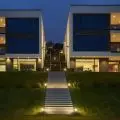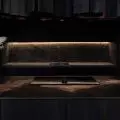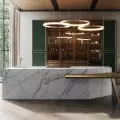Analyzing thirty years of Rzeszow's development, one can venture to say that decision-makers have turned the lack of spatial planning into a strategy that is tailor-made primarily for investors. As a result, today's city is a kind of urban-architectural experiment, whose authors are mainly developers. At the same time, the authorities have set ambitious goals for the capital of Subcarpathia. In urban policy there are references to an innovative city, smart city, metropolis. In this regard, will City Hall turn declarativeness into action? It has taken the first step by appointing Janusz Sepiol to the new office - the Architect of the City of Rzeszow.
Pawel Kraus: Let's talk about Rzeszow as a typical city - a large city of 200,000 people, with an area of more than 100 squarekilometers , being the capital of a province.
Janusz Sepiol: Well, exactly what type of city does Rzeszow represent? What group does it belong to? It would seem to be a simple question, but the answer poses many problems, because - in my opinion - it is a city in transition. Rzeszow is moving from one group to another.
Kopisto Avenue - Along Kopisto Avenue, more residential buildings with first floor services are being erected. Concrete squares stretch between the buildings and the sidewalk. Devoid of plantings and tightly packed with parked cars, they effectively obstruct pedestrian access to the buildings. As a result, a tract with metropolitan aspirations becomes an unattractive space for people.
Photo by Pawel Kraus
Pawel: Decision makers dream of a metropolitan Rzeszow. Is this the right direction?
Janusz Sepiol: The Polish city that is out of the competition in terms of metropolitan development is Warsaw. In addition to the capital, there is a group of nine large cities, which in Polish conditions we also call metropolises. They are developing with different dynamics. Perhaps the best are Wrocław, the Tri-City and Kraków. The second group includes cities aspiring to metropolitan status. It seems that Rzeszow is the leader in this group. It has recently managed to significantly improve its image as a very dynamic city, even though Rzeszow still falls short of many of the parameters of cities in the second group. The capital of the Subcarpathian region is, objectively speaking, an undersized city, to which extensive rural areas have recently been added. But when we look, for example, at such an indicator as budget income per capita, Rzeszow ranks on the border of the top ten in Poland. If we look at air traffic, primarily cargo traffic, the Jasionka port is in the top ten. And most importantly, if we look at construction traffic, the number of housing units handed over per thousand residents, Rzeszow ranked first in the country in 2020. The number of construction starts and building permits issued give confidence that for the next year or two Rzeszów will continue to be the fastest growing city in Poland in this regard. This, of course, has its shadows. In terms of coverage of the city's area with zoning plans among the sixteen provincial cities, Rzeszow is last. Thus, it can be said that it is a rapidly growing city, but without strategic thought, without harmonizing growth with strategic planning. The scale of plan coverage shows that there is a gap in development programming.
Now let's look at Rzeszow through the lens of metropolitan functions. Is Rzeszow a place of significant financial operations? Is it a place of creation, knowledge-based innovation? Is Rzeszow home to the headquarters of banks, headquarters of large companies? In the case of the banking sector, no city outside of Warsaw counts. But in the case of locating headquarters of large companies, some cities already have something to boast about. In this sense, Rzeszow is not yet a metropolis. If we are talking about intellectual potential, the sphere of creation, innovation, then Rzeszow rightly boasts that a university and a polytechnic operate here, but both universities are in rather distant positions in their rankings. This situation can and should be changed. Of course, Rzeszow's universities will not compete with Jagiellonian University or Warsaw University of Technology, but the universities in Olsztyn, Białystok, Bydgoszcz, Kielce, Opole could easily be overtaken. Another aspect of metropolitanity is space, architectural shape, character of streets, squares, public interiors that give a sense of metropolitanity. In Rzeszow, there is a belief that the symbol of metropolitanity is the height of buildings. And it doesn't matter that these are residential, non-office buildings. Are there other buildings in Rzeszow that communicate the metropolitan functions of the city? In principle, there aren't. Let's look at the competition, for example, what bus station is being built by Lublin, what philharmonic has been built by Kielce... What impressive concert hall has been erected by Toruń, what libraries have been built by Gorzów Wielkopolski, Opole or Jaworzno? Rzeszow lacks significant realizations of public facilities. A great number of them have been erected in Poland in recent years, but Rzeszow has not participated in this process. These facilities have yet to be programmed and made sure that they are characterized by high-quality architecture. In a sense, this is a great opportunity for the city.
The Trade Fair Hall, one of several outstanding public buildings constructed in Rzeszow after World War II (construction - Stanislaw Kuś), is effectively disfigured by successive "modernizations" and the disheveled stalls set up around it.
Photo: Pawel Kraus
Pawel: How do you assess the city's strategic documents in this context? It is difficult to find in them the investment optimism you just mentioned. After a few months in office and in view of the preparation of the next strategy, have you defined the directions of Rzeszow's development with regard to the shaping of space?
Janusz Sepiol: The strategy for Rzeszow is a broader issue. The current document from 2015 has already become somewhat outdated, and it is in fact so extensive and at the same time finicky that it is difficult to identify its priorities. I think recent political developments, including the influx of immigrants and the new political role of the city, require a completely new approach. And as for spatial issues, of course there are some areas where I see my responsibility. First of all, I will work to organize investment processes, to reduce the importance of zoning decisions in the development of the city. I will strive for the creation of places and objects that will become a showcase and a new characteristic of Rzeszow. It is necessary to define these investment tasks and ensure their implementation through competition. In this context, a good recent example is the settlement of the competition for the construction of the Podkarpackie Children's Health Center [the competition was won by the Atelier Tektura studio - editor's note]. The first- and second-prize winning works are simply great designs. But a while ago I participated in the committee where the design of the nursery and kindergarten was evaluated. It was prepared in the mode of seeking the cheapest bid and the result is a very uninteresting project. In this matter I am on speaking terms with the mayor - we will implement all public investments through competitions. Several such topics have already been outlined, we are starting to work on them. We hope that this will show Rzeszow - a city of innovation - as a place where architecture is an element of innovation.
Wislok River waterfront - The progressive development of Wislok River waterfronts, taking unprecedented decisions on development conditions, concreting more green areas in the city center with low-quality architecture by investors supported by the short-sightedness of decision-makers, is the legacy of the previous mayor of the city - Tadeusz Ferenc.
Photo by Pawel Kraus
Pawel: Since you mentioned the innovative nature of the city: these ambitions are enshrined in the brand strategy with the message "Rzeszow - Capital of Innovation. A city with class," I have to tell you that only 3 percent of respondents asked about the first thing that comes to mind when they think of Rzeszów associate the city with innovation, and less than 2 percent associate it with modern solutions. The gap is wide. Should we continue to think of Rzeszow as an innovation capital?
Janusz Sepiol: Rzeszow is not a very big city, so it can be smarter, more agile, and in some aspects faster and better organized than larger cities. Just "smart." And when it comes to research, I'm skeptical. People, despite appearances, don't quite know what would be really useful, but they know exactly what they would like. A feature of smart leadership is to apply what is needed, not just what people feel like doing. Because they often don't know what they might want. Everyone experiences this when they start traveling and observing. People know that the city needs more greenery, but they don't know what that would mean in practice.
It seems to me that betting on innovation is a good idea. Rzeszow is underestimated as a place of advanced industry. I myself am surprised by the number of important industrial companies that have appeared here, and the quality of the industrial architecture. I think it's a surprise to anyone who comes to Rzeszow. Already in this context, the image of the city is uplifting.
Wislok River waterfront - The eastern waterfront of the Wislok River, is literally a battlefield between the developer and City Hall. As a result, Rzeszow residents have been cut off from walking and recreational areas.
Photo by Pawel Kraus
Pawel: Please tell me which way of managing the city, in terms of shaping space, is closer to you? Participatory, managerial? How do you imagine the relationship between the decision-maker and the resident in a "city for the people"?
Janusz Sepiol: It seems to me that the answer to the postulates of the famous urban planner Jan Gehl is the activity of the mayor of Rzeszow, who has the gift of being kindly among the people and responding to their problems: a longer lane for joining traffic, an additional bench, a new pedestrian crossing, a pocket park, and so on. There is a concrete need - there is concrete action. That's a lot of important, but ad hoc issues. And that's great. But next to it must be programmed actions in the perspective of several, several years. Preparing a ranking of the city's strategic needs is not easy. Please see what is happening near the market hall, or in Freedom Square, covered with neglected stalls. It can't go on like this. These are pressing problems that need to be solved. It is good to "attack" many such problems and see what the resistance of the matter is in each case. A big part of my activity these days is dealing with developers. They determine the dynamics of this city, organize jobs, operate financial resources and have various ideas, not always the happiest. In this context, good plans are needed for Rzeszow like air. A few plans must direct the actions of developers. The concept of developing the city solely on vouchers is dramatically wrong.
Paul: Is Rzeszow prepared for local plans? I mean the cost resulting from the enactment of such documents.
Janusz Sepiol: I don't know that for sure, but it is not a poor city, and the cost of planless development is certainly higher. If Gdansk is covered by plans at 80 percent and Rzeszow at 16, there is definitely room for change here.
I would like to return to the issue you started with: Rzeszow in comparison with other centers. All cities in Poland, except for Warsaw and Krakow, are experiencing a demographic crisis. Rzeszow, on the other hand, is the only city, besides Warsaw, with a positive forecast until 2050. If we look at the situation of some cities of similar size: Bydgoszcz, Gliwice, Kielce, Zabrze, the situation there is dramatic. Not to mention a large group of cities such as Tarnow and Krosno, which have lost their status as provincial cities. The mood of the street in Tarnow versus Rzeszow are different worlds. Dynamics, construction traffic, quality of public transportation. It seems to me that Rzeszow could be a city of a new type. It is a city with a modest heritage. It was - let's put it bluntly - provincial, with a population of less than forty thousand before the war. Its silhouette was not formed by towers or domes. Its silhouette is being formed today. There is no doubt that it is a metropolis in its birth phase.
Olszynki Park - On the western bank of the Wislok River, in the center of Rzeszow, in an area that until recently served a recreational and sports function (tennis courts), several dozen-story residential buildings of the Olszynki Park complex are rising above the surrounding two- to three-story buildings. The taller tower will be 161 meters, so it will surpass Warsaw's Cosmopolitan by 1 meter. In this case, the dominance of Rzeszow's architecture over the capital's residential buildings, comes down to size alone.
Photo by Pawel Kraus
Pawel: And isn't the silhouette defined by Socialist Realism and Socialist Modernism?
Janusz Sepiol: This is another point I would like to emphasize in my activity. Rzeszow has very good architecture of interwar modernism and great architecture of socialist realism. It also has some really good post-war modernist buildings. This tradition should be exposed, the architectural value of Rzeszow should be emphasized. Suffice it to mention the Philharmonic building [designed by Waclaw Kryszewski, Jerzy Mokrzynski and Eugeniusz Wierzbicki; reconstruction: KKM Kozien Architekci - editor's note] or the Podprom Arena [designed by Maciej Gintowt, Maciej Krasinski, construction: Stanisław Kuś - editor's note]. It's a little worse with churches from the 20th century.
Paul: One of them was designed by Romuald Loegler.
Janusz Sepiol: Just this one is the best - the Church of Our Lady of the Rosary in Baranówka.
Pawel: And next to us rises a building....
Janusz Sepiol:...office and residential building on Targowa Street. Yes, its first realization in Rzeszow. But Witold Cęckiewicz, the Gintowt Krasinski duo, the famous Warsaw Tigers group or Tomasz Konior also designed here.
Szafer Park - Wladyslaw Szafer Park, is a 19th century monument, a rarity, waiting for revitalization for many years. The city owns part of the establishment. Next to it, a developer is erecting a residential complex called the Park District, and without embarrassment is selling 800 apartments adjacent to the neglected green area.
Photo by Pawel Kraus





































